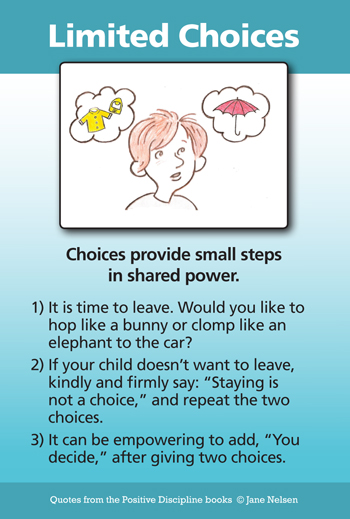One of the first classroom management tools that many of us learned, to redirect or set limits with children, is limited choices. This month, I’d like to explore this topic in some detail. I have found that the term limited choice is used frequently among Montessori educators, but just as often, it is used without an understanding of the principles behind the discipline tool that make it a respectful and effective way to interact with children and set clear and appropriate boundaries. Without an understanding of the principles, a discipline tool simply becomes a technique. Techniques fail because they are focused on the adult and the adult’s priorities, rather than on the child. The child becomes an object rather than the subject when the adult tries to employ a discipline tool as a technique.
Let’s first explore the principle behind limited choices. Using limited choices is a respectful way to set limits with children while honoring their right and capability to make appropriate choices for themselves, while respecting others. Limited choices let the child know that they are part of plan, but that there are limits that are developmentally appropriate and respectful to everyone involved.
Next, let’s explore what a limited choice is. A limited choice is simply a decision, given to a child by an adult, between two or more alternatives. The alternatives should be developmentally appropriate, reasonable, respectful and acceptable to the child, the adult and for the situation.
Some examples of appropriate, respectful and acceptable limited choices:
“You may eat the lunch your mother packed you, or you may make a peanut butter and jelly sandwich for yourself. You choose.”
“You may put away your yogurt first, or your cracker first. Which one do you choose?”
“You may scoop the beans off the floor with your hands, or with a whisk broom and dustpan. What would you like to use?”
“You may finish your math now, or after you eat snack. You choose?”
“Would you like to bring him the Peace Rose, or put this on the class meeting agenda?”
“You may write a report on any of the fundamental needs of the Ancient Romans. Please make your decision by tomorrow before lunch.”
“You have four overdue assignments. You’re welcome to do them after school while I’m preparing my lessons, come in early and work on them in morning care, or bring them home for the weekend. Which would you prefer?”
Adults, without realizing it, can find themselves in power struggles with students when they misunderstand the principles behind limited choices. This happens when an adult gives a student choices that are not developmentally appropriate, reasonable, respectful or acceptable to the child, the adult or the situation. Here are some examples:
“You may put your lunch away or go sit in the office.” (This is a threat, and not acceptable to the child.)
“You may come inside with the group, or stay on the playground by yourself.” (This is also a threat, and most likely an empty one that the adult cannot follow through with. It is not acceptable to the adult or the situation.)
“You may put your lunch away, or leave it on the floor to be stepped on.” (This is not acceptable or respectful to the situation and the community.)
“Would you like to do your math now, or during recess.” (This may not be respectful or acceptable to the adult who has other responsibilities after school, and not respectful to the student who needs time outside.)
“You may write a research report on anything that interests you.” (This choice is most likely too broad for the student, and therefore not developmentally appropriate. Some children may choose topics that are not acceptable to the adults, or the situation, and this will lead to rejection of the idea later by the adult. It’s not a choice in the end.)
Limited choices for younger children will be more concrete and limited, based on their developmental readiness. As students get older their choices will, appropriately, be broader. For instance, an adolescent may be given a much wider range of time to complete an agreed upon project, because they hopefully have developed the executive functioning to allow them to manage their time, make choices and experience the consequences (positive and negative) of those choices.
Sometimes, children will push back, with a response to a limited choice, like, “I don’t what to do either of those.” If this occurs, we can simply respond with a statement like this, “That’s not one of the choices,” and then just remain silent, warm and present! If the child persists, just remaining silent and waiting for them to respond, without reacting, sends a powerful message: I care. I trust you to follow through with your responsibilities, and I will do the same.
Until next time…





